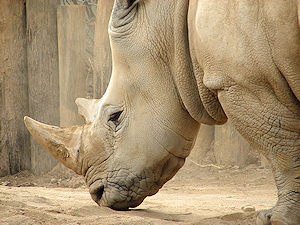White Rhinoceros Facts

Name: White Rhinoceros or Square-lipped Rhinoceros
Nick Name: Rhino
Latin Name: Ceratotherium simum (White Rhino)
African Names: Ubhejane (Zulu), Chipembere (Shona), Tshukudu (Tswana)
 Height: 5 feet to 6.5 feet
Height: 5 feet to 6.5 feet
Length: 11 to 14 feet including head and body
Weight: 3,000 to 8,000 pounds
Life Span: 30 to 35 years
Description: On the snout of a white rhino, it has two horns one behind the other. The white rhino has a hump on the back of its neck. It's feet has three toes. The color of a white rhino ranges from yellowish brown to slate grey.
Habitat: In general, white rhinos live in Africa in grasslands, savannahs and tropical bushlands.
Species: There are two subspecies of the white rhino: Northern White Rhino (Ceratotherium simum cottoni) and Southern White Rhino (Ceratotherium simum simum).
Babies: One baby is born about every 2 to 4 years. Gestation is roughly 16 to 18 months. Calves start weaning around two months, but may continue to suckle for up to 1 year.
Food: White rhinos eat leafy plants, shoots, thorny wood bushes, fruit, and leaves and branches of trees and shrubs. Rhinos use their horns to break branches and digging up roots for food.
Group Name: A crash of rhinos. White rhinos live in crashes of up to 14 animals.
Predators: Rhinos have no natural predators. Poaching is a big problem.
Endangered: Northern White Rhino - Extinct In The Wild - only 7 remain in captivity or semi-captivity.
Southern White Rhino - Not Threatened - Approximately 17,000 live in the wild with most of the Southern White Rhinos living in South Africa.
Nick Name: Rhino
Latin Name: Ceratotherium simum (White Rhino)
African Names: Ubhejane (Zulu), Chipembere (Shona), Tshukudu (Tswana)
 Height: 5 feet to 6.5 feet
Height: 5 feet to 6.5 feetLength: 11 to 14 feet including head and body
Weight: 3,000 to 8,000 pounds
Life Span: 30 to 35 years
Description: On the snout of a white rhino, it has two horns one behind the other. The white rhino has a hump on the back of its neck. It's feet has three toes. The color of a white rhino ranges from yellowish brown to slate grey.
Habitat: In general, white rhinos live in Africa in grasslands, savannahs and tropical bushlands.
Species: There are two subspecies of the white rhino: Northern White Rhino (Ceratotherium simum cottoni) and Southern White Rhino (Ceratotherium simum simum).
Babies: One baby is born about every 2 to 4 years. Gestation is roughly 16 to 18 months. Calves start weaning around two months, but may continue to suckle for up to 1 year.
Food: White rhinos eat leafy plants, shoots, thorny wood bushes, fruit, and leaves and branches of trees and shrubs. Rhinos use their horns to break branches and digging up roots for food.
|
Predators: Rhinos have no natural predators. Poaching is a big problem.
Endangered: Northern White Rhino - Extinct In The Wild - only 7 remain in captivity or semi-captivity.
Southern White Rhino - Not Threatened - Approximately 17,000 live in the wild with most of the Southern White Rhinos living in South Africa.
This site needs an editor - click to learn more!
You Should Also Read:
Black Rhinoceros Facts
Western Black Rhino Officially Extinct
Related Articles
Editor's Picks Articles
Top Ten Articles
Previous Features
Site Map
Content copyright © 2023 by Jeanne Egbosiuba Ukwendu. All rights reserved.
This content was written by Jeanne Egbosiuba Ukwendu. If you wish to use this content in any manner, you need written permission. Contact
BellaOnline Administration
for details.



